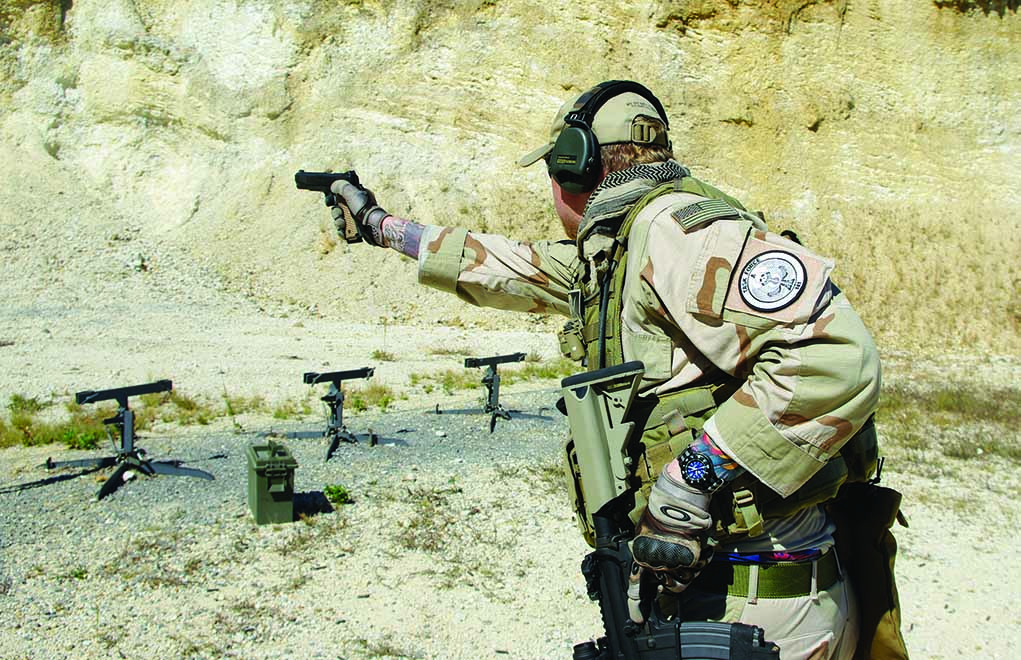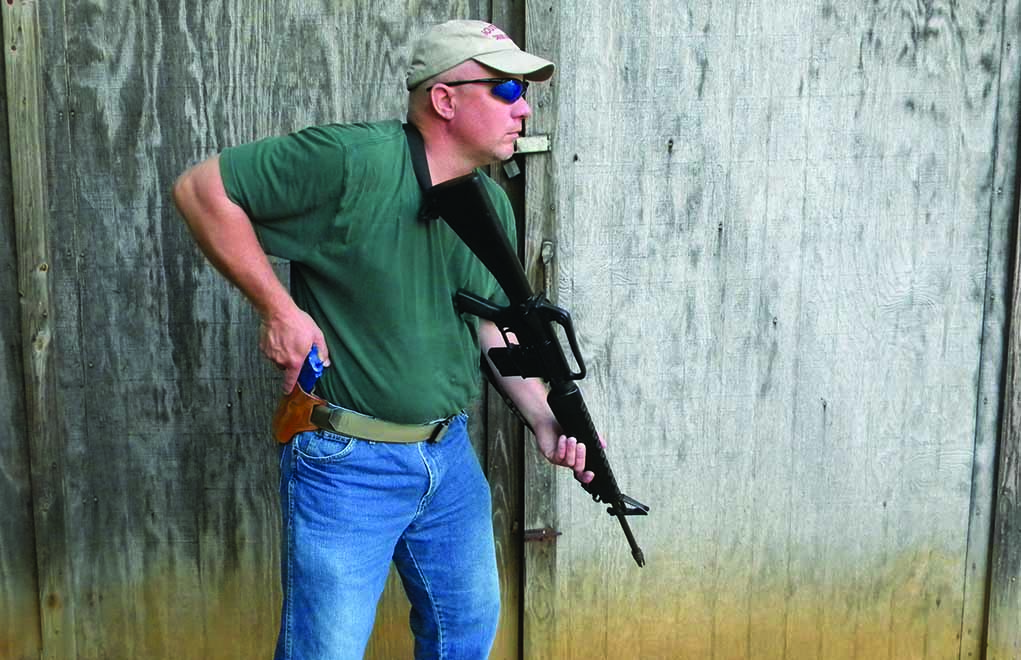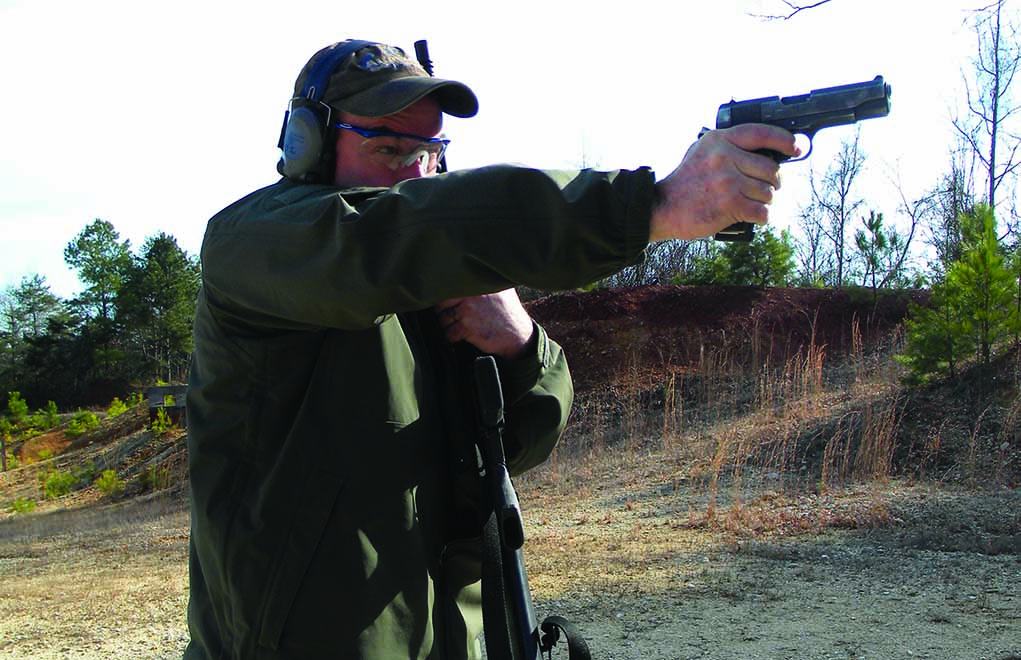
Some of the best practice a precision rifle shooter can experience comes from the trigger of a handgun.
Why precision rifle shooters should train with a handgun:
- Focus on fundamental form and technique.
- Understand mechanics of draw, presentation and shot.
- Effectively transition between hand and long gun.
- Become more safety conscious.
- Shoot more (more handgun ranges available).
As a precision rifle shooter, I see a lot of other shooters in my discipline neglect their handgun training. We are often so detail-oriented and wrapped up in tasks such as load development or software that we forget to return to the basics.

I used to say, “The handgun was only there to make noise until I reached for my rifle.” But that’s no longer my stance because I took the time to get training. I cannot overstate the value of a good, basic course of instruction. Even when I was teaching long-gun courses full time, during the breaks I would seek competent instructors to hone my handgun skills. In many cases, I would call in last-minute favors to get a slot in a pistol class. With all but one, I always took the basic handgun course. I find it the most beneficial to me to sharpen neglected skills.
Before the various rifle series competitions really took off, we used to include handgun stages in all our competitions. Even at a place called “Rifles Only,” we had a balanced focus on our handgun use. Each match had at least four stages that included handgun targets before, after or during our rifle engagements. Close in we fought back to our rifles, or after engaging our long-range targets we would fight away from contact. These stages in the match were always the most fun because it mixed up the pace.
Returning To The Basics

Today, Sniper’s Hide field competitions do include a few handgun stages: There aren’t as many as before, but we’re getting back to this tool because it’s an easy fix to sharpen our skills. But if long-gun shooters see no use for them, it’s easy to forget — and that’s not a good thing. Even as a devote student of the precision game, it’s important to balance your training and include a few handgun stages.
Return to the basics and focus on your form and your technique — you’d be surprised what a little pistol work will do to your long-gun skills. Stress accuracy regarding shot placement. Don’t worry about speed right off the bat — that will come after you fixed any fundamental flaws. Understand the mechanics of a draw and how to carry your handgun properly while also carrying a precision rifle properly. Can you access it with all your other gear? I see lots of images online of guys with leg holsters that drop close to their knees. While standing straight up, you want to be able to cup the bottom of the barrel while it’s in the holster. Letting it hang too far down restricts movement — and it just looks bad.
More Long-Range Shooting Resources:
- Buying the Perfect Precision Scope
- Exterior Ballistics Explained
- Ballistics Basics: Initial Bullet Speed
- Which Focal Plane Is Right For You?
- Holding Or Dialing For Drop And Windage?
Be sure to vet your instructors and stay away from the sensational types who want to make a name for themselves. If the highlight of their video reel is them standing next to a target, and the next scene has the student shooting at it with them there, please turn the page. I like guys such as Clint Smith and Larry Vickers — old-school instructors who have a serious take on fighting with a handgun. There are plenty others, especially in the field of speed shooting. Those guys would be my next step after establishing a solid foundation.
Mixing It Up Is A Must
If you work with a precision rifle, it’s essential to do transition training. Moving from the prone position behind your long gun, learn to engage targets to both the front and rear of your position. You want to be smooth and effective, moving in and out of the prone position during the draw phase, making sure your kit is not in the way to foul up the transition. Much of it is common sense in a lot of ways, but all too often I see it overlooked or completely forgotten.

My suggestion: For every 8 hours of precision rifle training, include a minimum of 1 hour of handgun work. That’s not too much, and it will increase your long-gun effectiveness by a wider margin than I can illustrate.
Don’t forget the safety: I see a lot of problems with precision rifle shooters when they have to shoot handgun stages. Safety became one of the reasons why handgun disciplines disappeared in specific events. With our long rifles, we apply more control. Put a pistol in those same hands, and it’s an instant safety violation. These things are not difficult to master, but they do take diligent practice and repetition.
The best part about practicing my handgun fundamentals is often a disadvantage to being a long-range shooter: There are handgun ranges everywhere. I can walk to the end of my block and there’s an indoor range. For my precision rifle work, I have to travel an hour. If you haven’t already, join a pistol range; many have weekly matches, and trigger time is trigger time, regardless of what you’re shooting.
Don’t get so tied up in your precision rifle work that you neglect your other options out there. Become a well-rounded marksman.
Editor's Note: This article originally appeared in the September 2018 issue of Gun Digest the Magazine.

Next Step: Get your FREE Printable Target Pack
Enhance your shooting precision with our 62 MOA Targets, perfect for rifles and handguns. Crafted in collaboration with Storm Tactical for accuracy and versatility.
Subscribe to the Gun Digest email newsletter and get your downloadable target pack sent straight to your inbox. Stay updated with the latest firearms info in the industry.

![Best Concealed Carry Guns In 2025 [Field Tested] Wilson Combat EDC X9S 1](https://gundigest.com/wp-content/uploads/Wilson-Combat-EDC-X9S-1-324x160.jpg)


![Best 9mm Carbine: Affordable PCCs [Tested] Ruger Carbine Shooting](https://gundigest.com/wp-content/uploads/Ruger-Carbine-Shooting-100x70.jpg)
![Best AR-15: Top Options Available Today [Field Tested] Harrington and Richardson PSA XM177E2 feature](https://gundigest.com/wp-content/uploads/Harrington-and-Richardson-PSA-XM177E2-feature-100x70.jpg)
